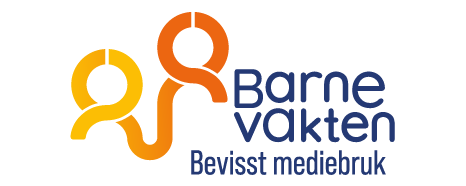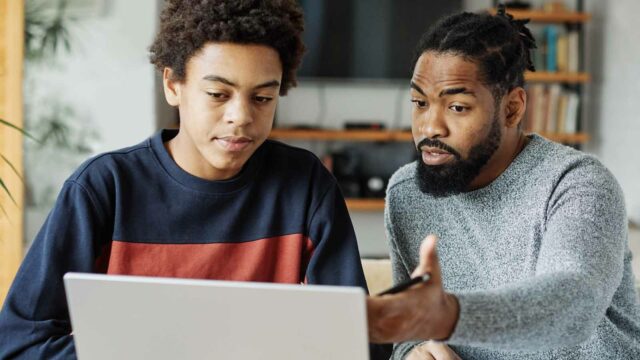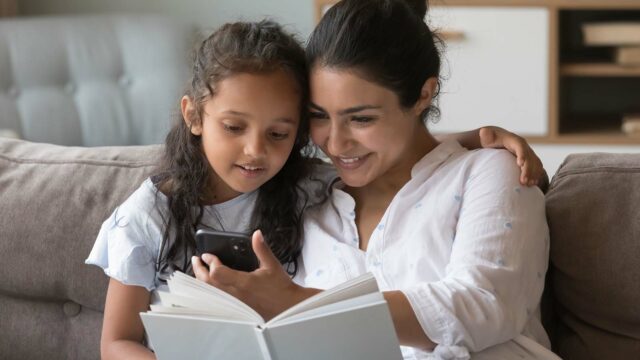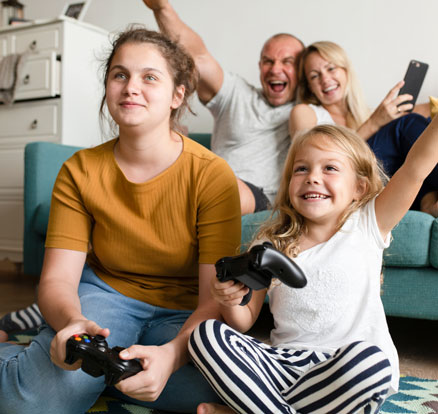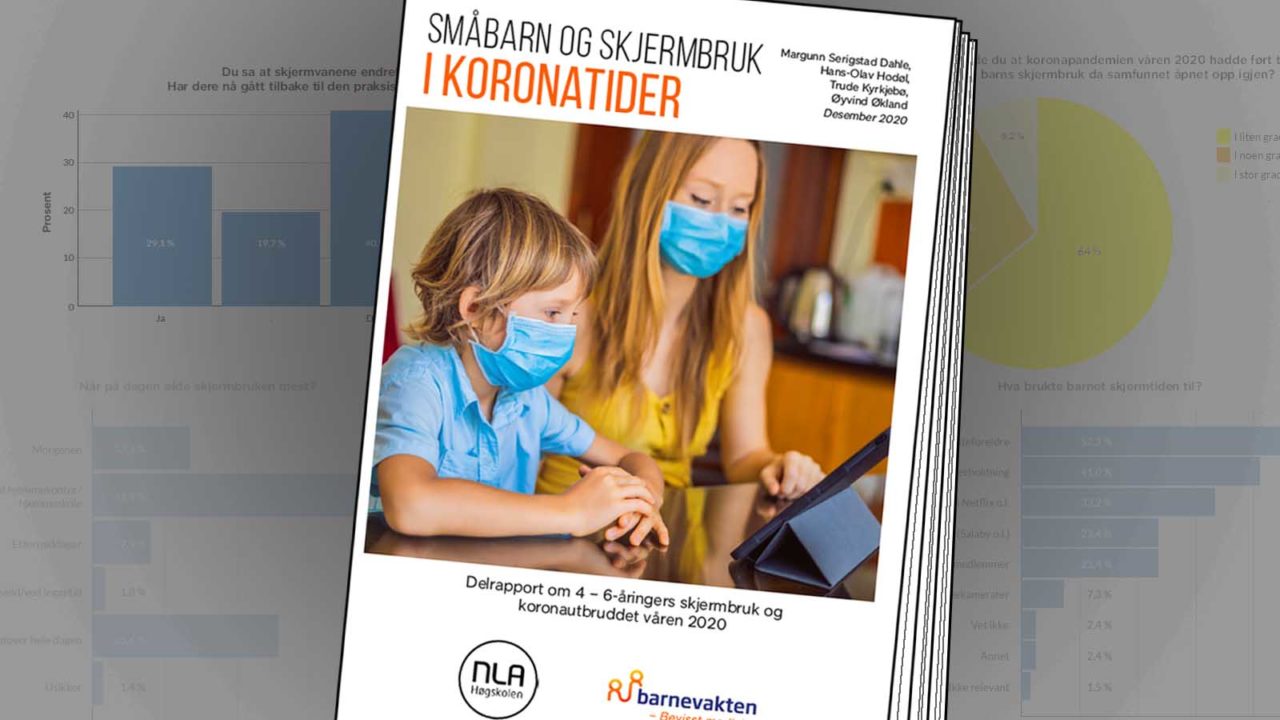
Children and internett during the corona time
Norwegian survey about 4 – 6-year-olds' screen use and the corona outbreak in the spring of 2020.
Choose language in the Google-box below. Some translations may be flawed or inaccurate.
«Skjermet barndom in the corona period?» About 4 – 6-year-olds’ screen use and the corona outbreak in the spring of 2020.
Background
In February 2020, Barnevakten released the Skjermet barndom? report, the report based on survey among parents and teachers on children’s screen use. The aim was to identify parents’ need for knowledge, advice, and guidance on children’s media use, as well as teachers’ need for resources regarding children’s media life. The research was conducted by a group of researchers affiliated with NLA University College.
Barnevakten also focuses on kindergarten–school transition and on the screen use of kindergarten children in the age group 4 – 6 years. A survey with the objective of identifying the key needs for knowledge, advice, and guidance among parents of this age group was planned to be completed in the latter half of March 2020. However, the research project had to be postponed due to the corona outbreak and the shutdown of the society on 12th March 2020.
It was not until August that it was appropriate to conduct the survey. We are very grateful that the management at the municipal kindergartens in Bergen and Vennesla, as well as the management of the Espira Group, Stiftelsen Kanvas and Læringsverkstedet AS kindergartens, had agreed to pass on the web-based questionnaires to the relevant parent groups. The survey was anonymous and was available in nine different languages in addition to Norwegian with the potential to reach parents/guardians of over 14,000 children. It was available through September, and about 20 percent of potential respondents responded to the full survey.
Because of the corona outbreak, it was natural to integrate a separate question block related to parents’ experiences with 4 – 6-year-old’s screen use during the time the kindergartens closed in the spring of 2020. The findings of this particular block form a separate section of the research report that will be published on Safer Internet Day 2021 and will be subject to reflection in light of theoretical perspectives and relevant research within the larger totality of the report.
In this note, we present a few key tendencies based on the empirical material associated with the corona outbreak. Please note that findings related specifically to the needs for competence expressed by the parents on the basis of their experience with the corona outbreak in the spring of 2020, are not affected here. This aspect must be seen in relation to the needs for knowledge, advice, and guidance the respondents demand in connection with the children’s screen use in general and is reflected within the larger framework of the report released in February.
Introduction
When Covid 19 struck Norwegian society in March 2020, it led to drastic changes in everyday life for both children and adults. This research study shows that the period from 12th March to the gradual opening of kindergartens from April 17 (1) was particularly demanding for many families at the same(2) time as the “state of emergency” marked the months leading up to the summer.
It was (and is) a state of emergency (parent)
As stated above, we, therefore, in a separate section of the questionnaire, focus on the parents’ experiences with 4 – 6-year-old’s screen use during these special weeks in the spring of 2020.
When the society «overnight» underwent major structural changes, kindergarten children, with older siblings in particular, felt the consequences. Now the parents would have a home office at the same time as both the school and the kindergarten were closed. In such a situation, the screen became an important source of play, learning, and entertainment for the children, while the screen time aroused both enthusiasm and concern in the adults.
The survey shows that parents consistently have an experience of having too much screen time on 4 – 6-year-olds. There is also a clear tendency for parents to place more emphasis on how much time their children spend on screen activities than on screen content. However, the focus on learning is clear.
More screen time
There was too much screen time when the kindergarten was closed (parent)
The findings clearly show that screen time increased with 45 per cent of respondents reporting home office and home school for older siblings as the main reason for this. The figure below shows that for almost 50 per cent of 4 – 6-year-old’s screen use increased mostly in connection with older siblings’ schoolwork and their focus on their own work:
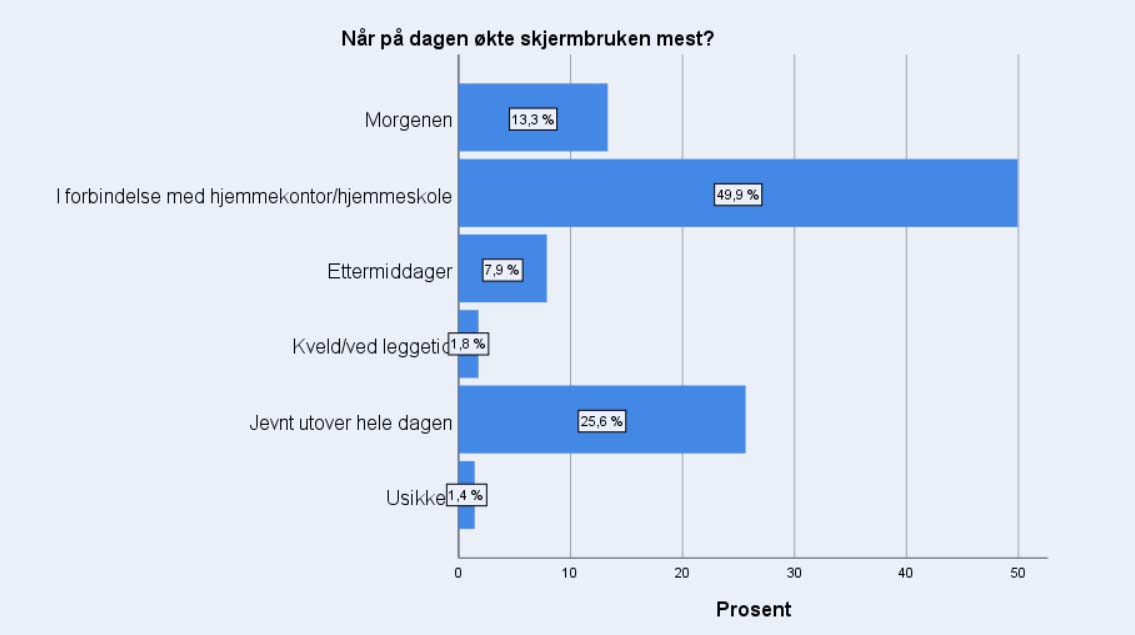
When the respondents state that there was too much screen time for 4 – 6-year-old, «too much» is however a flexible term. But regardless of what one perceives as ‘too much’, more than 70 per cent of respondents say that 4-6-year-old’s screen use increased ‘to a large extent’ or ‘to some extent’:

Respondents’ answers to what they think about the changes show that 55 per cent experienced this as negative, while 37 per cent were neutral. Linked to statements in the free text field, we see that this «both – and » attitude is prominent.
I think that it was a «necessary evil» that at the same time was for pleasure/relaxation (parent).
In line with the fact that it is difficult to infer about what is perceived to be «too much», we also cannot say anything about what the increase meant in relation to 4 – 6-year-olds’ total time spent on screen. However, in the majority of the survey, two out of three respondents (67.1 per cent) say that their child uses the screen for less than two hours on weekdays, while 22.8 per cent estimate two to four hours as the most common. Based on the free text answers, between half an hour and two hours seems to be the usual time frame for children’s screen use in our material. In these weeks in the spring of 2020, this time use increases ‘to a large extent’ or ‘to some extent’.
Minor variation in screen usage
A natural consequence of the fact that for many the home became a new arena for work, school and kindergarten provided less opportunity to follow the 4- 6-year-old’s screen use. The answers show that the screen could act as a «babysitter» in the complex everyday life. Several statements in the free text field support such a thought:
«The kindergarten child clearly became the «losing party» at home during the corona period. Mother alone with three children, two of them are schoolchildren. Mother had to sit and help with homeschooling from 8:30 a.m. to 1 p.m., and had to stow away the nursery child with Netflix. It felt absolutely terrible, but I had no choice! Could not have solved it in another way without there would then be disruption in the schoolwork of schoolchildren (parent) .
The survey also shows less variation in screen use during this period compared to the time before the corona outbreak. The number of respondents who ticked that the child used the screen in three or more areas decreased by 10 percent during these weeks. While the percentage is 53.2 percent on similar questions in the main part of our survey, it is here at 43.2 percent.
As can be seen in the figure below, streaming services such as Netflix, and the like what most respondents state that 4 – 6-year-olds used the screen for in those weeks. Nearly 70 percent of the total number of parents ticked this screen use, while 50 percent of the respondents stated games/entertainment, and 45 percent ticked for conversation/contact with grandparents:
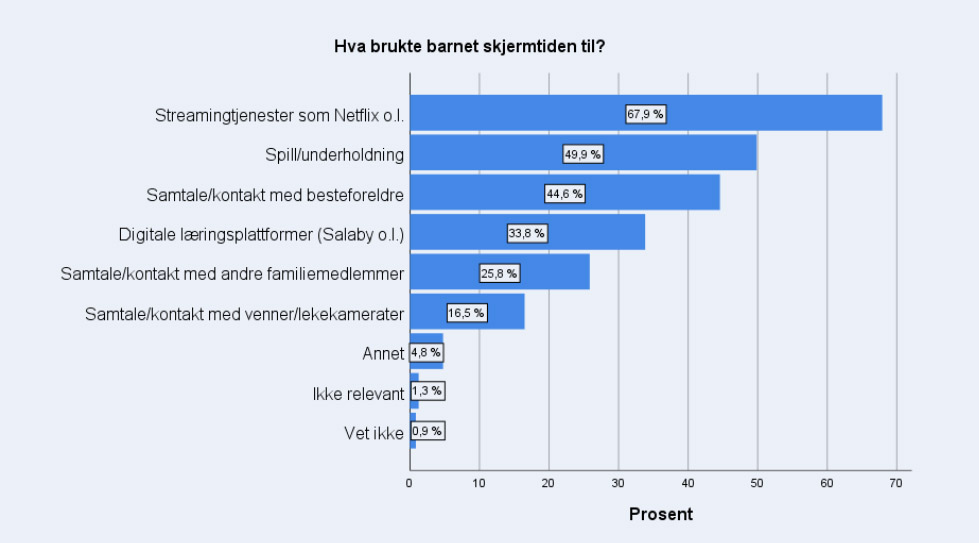
If we look at what 4 – 6-year-olds spend the most time on of the different screen activities they do, it turns out that 55 per cent of the parents state that it is the stream services.
If we go back to the question of what the children used screen time for, and then only looking at the answers from the group of respondents who chose to use a different language version of the questionnaire than the Norwegian one, it turns out that just over 30 percent of parents say that their children used Netflix and other streaming services. Game/entertainment is just over 40 percent here. However, more than half of the respondents who used a language other than Norwegian ticked the check box for contact with grandparents:
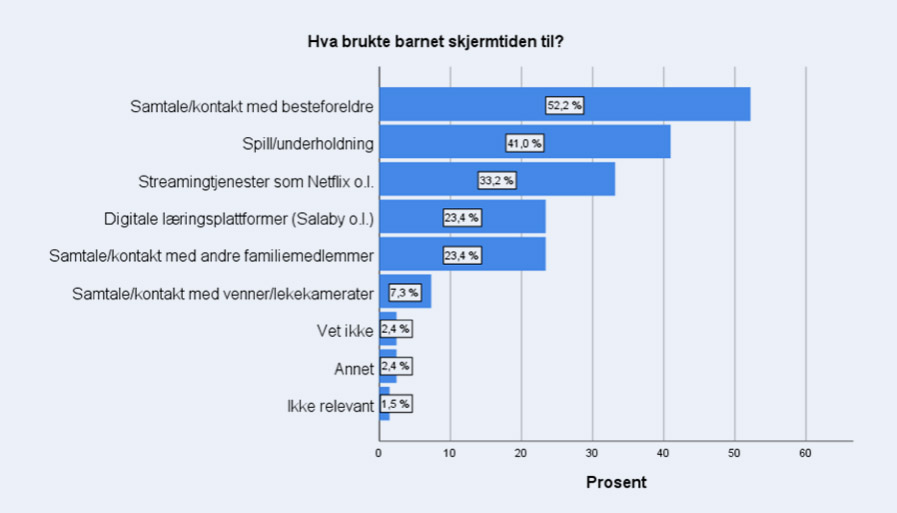
The findings thus indicate that several minority language speakers used the screen to maintain contact with grandparents compared with the responses from the overall respondent group. At the same time, significantly fewer of the minority-language group of parents state that their children have used the screen to connect with friends. The relational social aspect associated with the use of a screen is therefore somewhat different when looking at the linguistic background of the parents in our material.
NRK Super – an illustration
On the basis of the high percentage of parents who ticked on services such as Netflix etc., we contacted the country’s largest public broadcaster NRK with questions about possible statistics on how the use their services for 4 – 6-year-olds was in these weeks.
NRK Super is very popular in our target group. This is clearly stated in the survey Parents and Media 2020 (Media Authority 2020), and is confirmed by analyst at NRK Super, Henrik Skatvedt, who says that 4 – 6-year-olds account for approximately 20 per cent of all consumption in NRK Super TV. Our material does not map program preferences etc., but in the free text fields, NRK Super is mentioned several times, such as here:
We used a lot of NRK Super and think that with children, this is something nice to relax with. (parent)
From the school’s side, it was for an older sibling arranged for some TV (school-children’s TV on NRK Super, for example). We let our kindergarten child watch this, and thought it was just fine. (parent)
I think it’s fine with Children’s TV and a bit of a couple of episodes on the NRK Super app. Sometimes we see a music video on YouTube. Then the child dances and laughs and cuddles. (parent)
When direct questions to Skatvedt, we learned that NRK Super TV experienced some of its best weeks ever from week 11, when Norway shut down due to the corona outbreak, through week 22, which was the last week of May. The percentage growth in weeks 11 – 22 in 2020 compared to 2019 was 20.5 per cent. Furthermore, the children’s content in NRK TV had an increase of 76 per cent in weeks 11 – 22, compared to the same weeks in 2019.
Excluding the month of December, the corona period from March through May was the best weeks in Super’s history. (Skadtvedt, NRK)
Skatvedt also points to Supernytt as a good indicator that the children searched for NRK, especially during the first weeks of the outbreak. Among the viewers here are also young children (Nesheim, 2018), and the program post is thus relevant to our target group. As early as Monday 16 March, the Government together with NRK Super and Aftenposten Jr. arranged its own press conference(3) for children, with Prime Minister Erna Solberg in the lead. From 18 March, Supernytt broadcast linearly on NRK1 at 17:50 every weekday.
The broadcast on March 25 was the most watched Supernytt broadcast ever, with a web rating of 92,000 viewers. This is about three times as much as normal. (Skadtvedt, NRK)
NRK Super clearly emphasized to include the children and give them the necessary information in the special situation, something that music video Together alone(4) (27 March) shows. Among others, here sings one of the favorites to the smallest children, Fantorangen, together with Prime Minister Solberg, about what it’s like to have a different everyday life during the virus outbreak.
NRK Super’s experiences in these 12 weeks during the corona outbreak in the spring of 2020 both underline and give a framework for the trends that emerge in our survey.
Varied experiences with screen use
So what picture does the survey of parents’ perception of children’s screen use during the corona outbreak in the spring of 2020 provide? We asked the respondents to write up to three key words describing respectively positive and negative experiences. These keywords formed the basis for two word clouds, based on the number of instances of words.
Positive erfaringer
In general, the respondents express that they experienced a lot of positive things with the 4- to 6-year-old’s screen use during the corona outbreak this spring. The word cloud below gives an indication of words that are often mentioned in the respondents’ answers when they were asked to write up to three key words that describe positive experiences during this period:
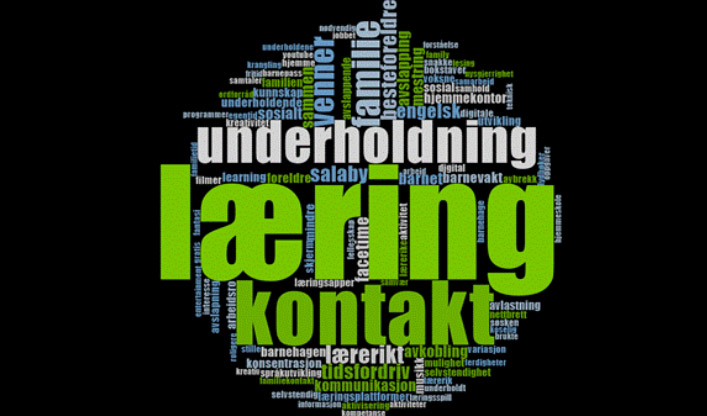
The word ‘learning’ has the most occurrences, and is mentioned 680 times. As can be seen in the figure that illustrates what the child used the screen time for, 33.8 per cent of the respondent group as a whole put markings on digital learning platforms. Compared with the total group of respondents, however, there are fewer minority language parents – only 23.4 per cent – who have ticked here. One interpretation may be lower access to tablets among children with a minority language background, which our data material shows is the case.
For children, ‘learning’, both as a concept and a phenomenon, is closely linked to play. Since ‘play’ does not appear among the most used here, it is interesting to do a deliberate search for this word in the data material. The result shows 74 occurrences, and thus ‘learning’ is used almost 10 times as many times as ‘play’. The same tendency shows again in the free text fields.
That it is ok with screen use as long as it is in a limited amount and does not go beyond the child’s opportunity for outdoor or indoor play. (parent)
Although play and learning are closely linked and children’s screen use will often be a mixture of play, learning and entertainment, the parents’ response gives the impression that the play perspective is not linked to screen use here. The term ‘edutainment’ is used about a combination of play, entertainment and learning, often related to digital tools. The parents in this study express that such learning and entertainment is in opposition to play and free activities, preferably outside.
‘Entertainment’ is used by almost 235 respondents and shows well again in the word cloud above. Although this is only one third as many as those who wrote ‘learning’, it indicates that entertainment is perceived as positive. As we referred to above, gaming and entertainment was one of the three most popular uses of the screen among children, along with streaming services and the ability to chat with others via the screen. The use of ‘entertainment’ here gives an indication that the parents experience this as positive.
It was used to break up the day so both children and parents could relax with a nice movie together. It became a nice routine for us when little sister slept. (parent)
Another feature of the screen use during the corona outbreak that many of the respondents emphasized was the contact with family and friends. If we examine how many of the respondents have marked for one or more forms of conversation / contact that the child has used the screen for, then the answers show that this applies to more than half (51.4%). Among those with a minority language background, almost six out of ten respondents (58.5%) state that the child has used the screen for this purpose. In the word cloud above, «contact» has been used almost 400 times, and several statements in the free text areas emphasize the same.
It was also a great way to stay in touch with family and friends. Among other things, Grandma read books on FaceTime to great delight both children and Grandma. (parent)
Problematic experiences
When the respondents in the free text fields point to specific negative aspects of the increased use of screens in this phase, little body movement, play and creativity are highlighted, in addition to a lot of sitting still. Several also point to physical consequences such as that screen use can be harmful to the eyes and result in poorer sleep. Monotonous days and the challenge of being left to yourself are also mentioned by several.
It was probably a little too much, but when the adult had to spend his time as a teacher for a 1st grader, the kindergarten child was left to himself largely. (parent)
Not quite good. Due to follow-up of siblings with homework etc., the youngest was handed over to a tablet under supervision. (parent)
In the cloud of problematic experiences with screen use in the corona period, we find words that reflect what parents worry about in connection with the child’s screen use:
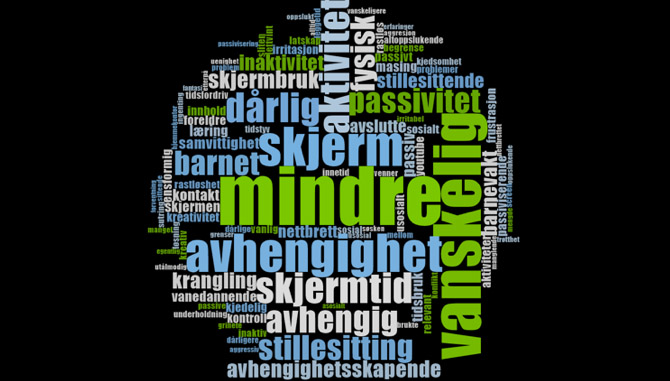
To this request, there is a far greater spread in the answers. Words that occur frequently are ‘addiction’, ‘passivity’ and ‘sitting still’, all of which express that the parents’ concern is particularly about what screen use displaces from other activity. The indication that the actual use of time creates concern corresponds with the impression from statements in the free text field, such as:
Ok as long as screen use is balanced with play and outdoors.
A main impression based on the empirical material is precisely related to the fact that the parents experienced it as demanding to find a good balance between the child’s screen use and other activities. Although the respondents generally express positive aspects of the child’s screen use, a preliminary and reserved interpretation is that the parents have a critical attitude to the increased screen use during the corona outbreak in the spring of 2020, as the diagram illustrates:
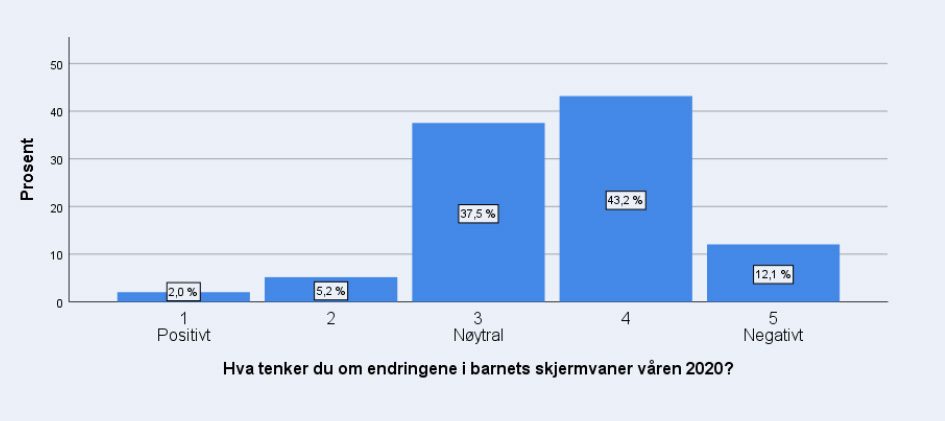
Different degrees of change in habits as of September 2020
When asked to what extent they experienced that the corona outbreak in the spring of 2020 had led to changed habits in the child’s screen use when society gradually reopened in May, about a third of the parents confirmed that this was the case:
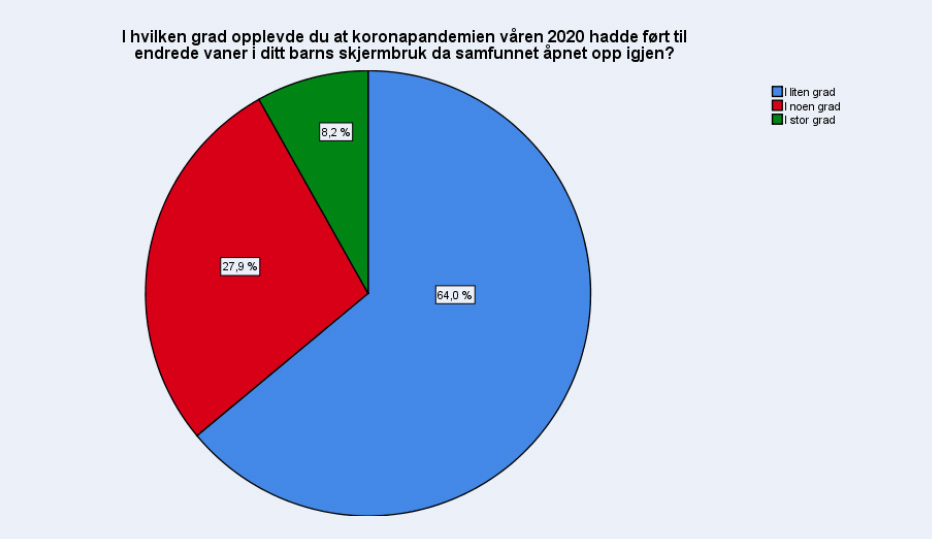
For the group of respondents who used a different language version other than Norwegian, more than half (53.2%) answered that the child’s changed screen habits persisted even in the time after the society reopened.
The respondents who had confirmed that their screen habits changed during the corona outbreak were asked if at the time of the survey (September 2020 – i.e. five months later) they had reverted to the practice they had before March 2020. The majority confirm that this is the case on the way, but only 29.1% answer an unequivocal ‘Yes’ to the question.
If we add up the three answer categories that lie between ‘Yes’ and ‘No’, we find that 68.2% of the respondents have used one of these categories. This may signal that among those who had changed screen habits in connection with the corona outbreak, the new practices still persisted at the time the survey was conducted.
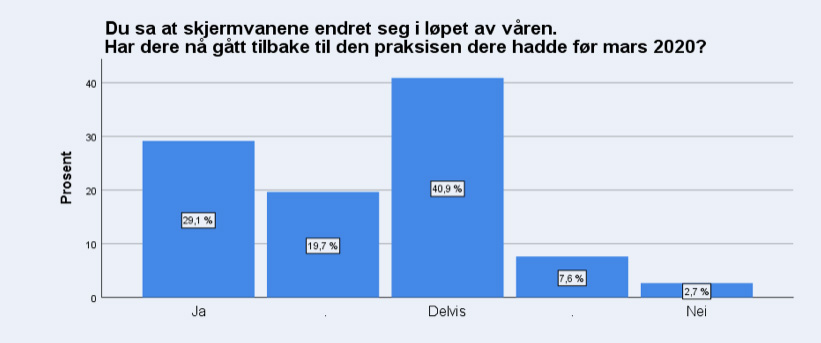
If we study the answers to different groups of respondents, we find that minority language respondents, and respondents residing in small municipalities, to a lesser extent than others have used the answer category «Yes». On the other hand, the answers in our data material indicate that urban, Norwegian-speaking respondents with a high level of education more often answer «Yes» than other groups of respondents.
Summary
We have presented here some key trends from the part of the survey that is related to the corona outbreak in the spring of 2020. The findings outlined here in the report will be launched on Safer Internet Day 2021 and be interpreted and analyzed in light of typical features of the field of knowledge and contemporary context – and within the framework of the survey as a whole. The report will also answer the core question of parents’ need for more competence in meeting children’s screen use in light of the experiences during the corona outbreak, and reflect on it in relation to the general need for knowledge, advice and guidance that emerges in the data material.
In summary, we can point out here that the increased screen time did not lead to more variation in screen use. An overall group of respondents states that the children primarily used the screen for entertainment and contact, but with somewhat different emphasis, where linguistic background also seems to play a role.
The parents have mixed experiences with the child’s screen use during the corona outbreak, and the answers alternate between worry and excitement. Not least, it was experienced as demanding to find a good balance between the child’s screen use and other activities. There is a tendency for parents to see screen use as something that promotes learning, but as shadows for play and outdoor activities.
The parents in the material consistently express positive aspects of the child’s screen use. Not least, learning is highlighted here, along with entertainment and extensive social contact with family and friends. At the same time, the empirical material indicates that many parents are concerned about what is missing in the child’s everyday life when there is more screen time, which clearly marked the everyday life of the families in question in this very special phase.
The signals from the parents at the time of conducting the survey show that changed habits and practices in screen use as a result of the corona outbreak in the spring of 2020 were still valid for large groups of children. Given the current situation and the series of local corona outbreaks that have led to periods of closed kindergartens, it is interesting to note the signals from parents here. Habits that change as a result of an extraordinary situation persist to some extent even after the situation that caused the change has ceased.
December 2020 , Margunn Serigstad Dahle-leader for the research team NLA Høgskolen.
On behalf of the research team Hans-Olav Hodøl (senior lecturer in media production), Trude Kyrkjebø (university lecturer in pedagogy and PhD fellow in interdisciplinary child research), Øyvind Økland (professor of pedagogy with specialization in intercultural communication) and Margunn Serigstad Dahle (religion educator and first lecturer in communication and outlook on life).
Notes:
- See https://www.udir.no/tall-og-forskning/finn-forskning/tema/konsekvenser-av-smitteverntiltakene-i-barnehager-varen-2020/ (retrieved 10.11.2020)
- The weeks and months up to the summer were also characterised by changing routines and lower activity levels
When the questionnaire was sent out in September 2020, the situation was almost normal. - See https://www.regjeringen.no/no/aktuelt/statsministeren-holder-pressekonferanse-for-barn/id2693657/ (retrieved 11.11.2020)
- See https://www.nrk.no/presse/programomtaler/statsministeren-og-fantorangen-synger-sammen-i-musikkvideo-1.14964179 (retrieved 11.11.2020)
